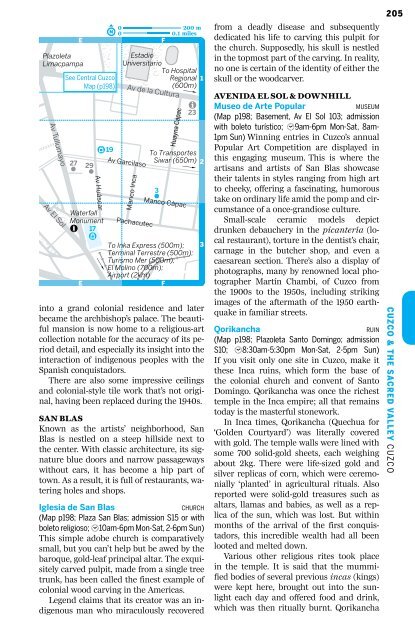peru-8-cuzco-sacred-valley
You also want an ePaper? Increase the reach of your titles
YUMPU automatically turns print PDFs into web optimized ePapers that Google loves.
66<br />
Plazoleta<br />
Limacpampa<br />
Av Tullumayo<br />
Av El Sol<br />
27<br />
6#<br />
E<br />
See Central Cuzco<br />
Map (p198)<br />
6<br />
6<br />
29<br />
#<br />
# þ 19<br />
Av Huáscar<br />
Waterfall<br />
Monument<br />
#á 17<br />
# þ<br />
E<br />
‚<br />
#e 0 0 0.1 miles<br />
200 m<br />
F<br />
Estadio<br />
Universitario<br />
Av Garcilaso<br />
Av de la Cultura<br />
Manco Inca<br />
Pachacutec<br />
3<br />
#<br />
Huayna Cápac<br />
Manco Cápac<br />
#ï<br />
23<br />
To Transportes<br />
Siwar (650m) 2<br />
To Inka Express (500m);<br />
Terminal Terrestre (500m);<br />
Turismo Mer (500m);<br />
El Molino (700m);<br />
Airport (2km)<br />
To Hospital<br />
Regional 1<br />
(600m)<br />
into a grand colonial residence and later<br />
became the archbishop’s palace. The beautiful<br />
mansion is now home to a religious-art<br />
collection notable for the accuracy of its period<br />
detail, and especially its insight into the<br />
interaction of indigenous peoples with the<br />
Spanish conquistadors.<br />
There are also some impressive ceilings<br />
and colonial-style tile work that’s not original,<br />
having been replaced during the 1940s.<br />
SAN BLAS<br />
Known as the artists’ neighborhood, San<br />
Blas is nestled on a steep hillside next to<br />
the center. With classic architecture, its signature<br />
blue doors and narrow passageways<br />
without cars, it has become a hip part of<br />
town. As a result, it is full of restaurants, watering<br />
holes and shops.<br />
Iglesia de San Blas<br />
CHURCH<br />
(Map p198; Plaza San Blas; admission S15 or with<br />
boleto religioso; h10am-6pm Mon-Sat, 2-6pm Sun)<br />
This simple adobe church is comparatively<br />
small, but you can’t help but be awed by the<br />
baroque, gold-leaf principal altar. The exquisitely<br />
carved pulpit, made from a single tree<br />
trunk, has been called the finest example of<br />
colonial wood carving in the Americas.<br />
Legend claims that its creator was an indigenous<br />
man who miraculously recovered<br />
F<br />
‚<br />
‚<br />
3<br />
from a deadly disease and subsequently<br />
dedicated his life to carving this pulpit for<br />
the church. Supposedly, his skull is nestled<br />
in the topmost part of the carving. In reality,<br />
no one is certain of the identity of either the<br />
skull or the woodcarver.<br />
AVENIDA EL SOL & DOWNHILL<br />
Museo de Arte Popular<br />
MUSEUM<br />
(Map p198; Basement, Av El Sol 103; admission<br />
with boleto turístico; h9am-6pm Mon-Sat, 8am-<br />
1pm Sun) Winning entries in Cuzco’s annual<br />
Popular Art Competition are displayed in<br />
this engaging museum. This is where the<br />
artisans and artists of San Blas showcase<br />
their talents in styles ranging from high art<br />
to cheeky, offering a fascinating, humorous<br />
take on ordinary life amid the pomp and circumstance<br />
of a once-grandiose culture.<br />
Small-scale ceramic models depict<br />
drunken debauchery in the picantería (local<br />
restaurant), torture in the dentist’s chair,<br />
carnage in the butcher shop, and even a<br />
caesarean section. There’s also a display of<br />
photographs, many by renowned local photographer<br />
Martín Chambi, of Cuzco from<br />
the 1900s to the 1950s, including striking<br />
images of the aftermath of the 1950 earthquake<br />
in familiar streets.<br />
Qorikancha<br />
RUIN<br />
(Map p198; Plazoleta Santo Domingo; admission<br />
S10; h8:30am-5:30pm Mon-Sat, 2-5pm Sun)<br />
If you visit only one site in Cuzco, make it<br />
these Inca ruins, which form the base of<br />
the colonial church and convent of Santo<br />
Domingo. Qorikancha was once the richest<br />
temple in the Inca empire; all that remains<br />
today is the masterful stonework.<br />
In Inca times, Qorikancha (Quechua for<br />
‘Golden Courtyard’) was literally covered<br />
with gold. The temple walls were lined with<br />
some 700 solid-gold sheets, each weighing<br />
about 2kg. There were life-sized gold and<br />
silver replicas of corn, which were ceremonially<br />
‘planted’ in agricultural rituals. Also<br />
reported were solid-gold treasures such as<br />
altars, llamas and babies, as well as a replica<br />
of the sun, which was lost. But within<br />
months of the arrival of the first conquistadors,<br />
this incredible wealth had all been<br />
looted and melted down.<br />
Various other religious rites took place<br />
in the temple. It is said that the mummified<br />
bodies of several previous incas (kings)<br />
were kept here, brought out into the sunlight<br />
each day and offered food and drink,<br />
which was then ritually burnt. Qorikancha<br />
205<br />
Cuzco & the Sacred Valley S C I u G zC H T O S


